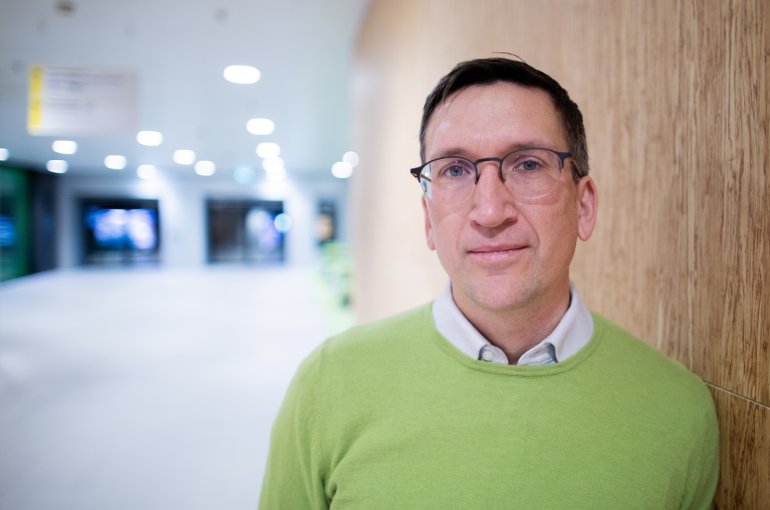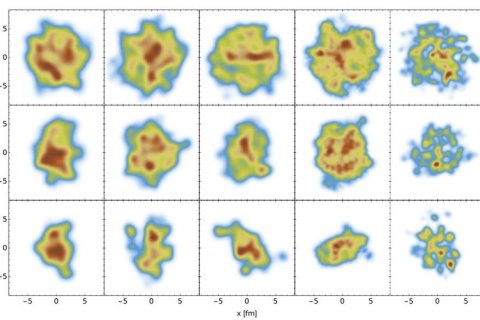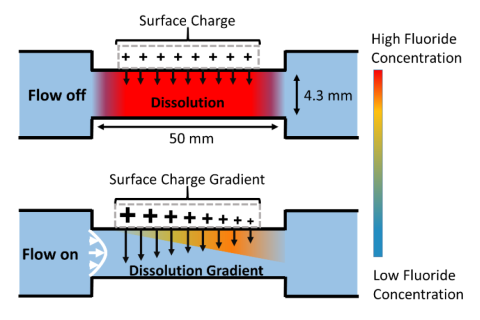Theoretical Physics News
Support for scientists and students from Ukraine
The Institute for Theoretical Physics and the Department of Physics are reaching out to scientists and students in (theoretical) physics from Ukraine to offer support, e.g. by offering office space or otherwise. Those interested are asked to contact the head of department, prof. Stefan Vandoren (s.j.g.vandoren@uu.nl). The department is also willing to consider similar requests from researchers and students who have fled Russia or Belarus.
Winners 30th NTvN Contest
This year marked the 30th time that the Dutch Journal of Physics (NTvN) organised a competition for PhD students. PhD students and recent PhD graduates could submit an article about their PhD research, written in such a way that it would be understandable to all NTvN readers. This PhD research may be either physics or physics-related. Former ITP PhD student Pieter Gunnink wins NTvN award. For more information (which is only available in Dutch) click here external link.
Matthieu Verstraete appointed as professor in Ab Initio Simulations of Quantum Materials

Matthieu Verstraete has been appointed as professor in Ab Initio Simulations of Quantum Materials at the Faculty of Science at Utrecht University as of 1 November 2023. The new professor predicts, via computer simulations, how materials behave at the quantum level under specific conditions, such as high temperatures or pressures. "Understanding the mechanism behind a material allows us to discover new things that we didn’t know were possible."
Matthieu Verstraete is on a quest for more sustainable, cost-effective and safer alternatives to existing materials. "Many materials used in technological gadgets such as batteries and phones face issues with electrical conduction, leading to energy loss in the form of heat," he explains. "Furthermore, some materials are toxic, like lead, or sourced through mining under poor ecological or humanitarian conditions."
Quantum materials
Potential candidates for more future-proof materials are quantum materials. These substances behave differently than 'ordinary' materials like wood, plastic, or stone, due to the properties of their smallest constituent particles. Because of these particles' properties, quantum materials can conduct electricity without energy loss or possess super strength or magnetism. Such materials are crucial in areas like the energy transition and the development of new technologies.
Simulations over experiments
Many quantum materials do not yet exist, and their production process is expensive and time-consuming. Additionally, a new material needs testing in a lab to determine its usability for the intended purpose. Verstraete bypasses this costly and time-consuming process by using simulations to predict the properties of new quantum materials.
Simulations let us explore thousands of not-yet-existing materials and extrapolate the five best, without spending millions on experiments.
Verstraete’s research doesn't take place in a lab; there are no experiments involved. He and his team solely use computers. Simulation renders the research more efficient, the professor explains: "By using simulations, we can explore hundreds or even thousands of not-yet-existing materials and extrapolate the five best, without having to invest millions in experiments."
AI as an aid
One of Verstraete's objectives after his appointment as a professor at Utrecht University is to study how materials conduct heat. Some materials insulate well (useful for homes to retain warmth), while others conduct heat excellently (useful in cooling computers to prevent overheating).
Calculating heat conductivity for each material is time-consuming. Verstraete and his team employ machine learning to train a computer program based on a small quantum calculation dataset. “This enables it to predict how atoms move in a given material, and speeds up the process by about a thousand times,” explains Verstraete. "AI is in vogue, but it's also truly efficient when incorporated cleverly into your methods."
Exponential growth
Verstraete hopes for exponential growth in the number of materials capable of storing energy and absorbing CO2. Countless existing materials might be capable of much more than we think, he suspects. These remained undiscovered because the materials were never tested under the right conditions, and simulation methods might unveil their hidden properties. Verstraete: "I'll keep searching for materials that have never been explored, but also for new methods to investigate materials."
About Matthieu
Matthieu Verstraete's interest in quantum physics and materials science sparked early. He studied Engineering Physics in Lausanne, Switzerland, and pursued doctoral research in Materials Science in Belgium. After post-docs in the UK and Spain, in 2009 he became professor in the Department of Physics of the University of Liège (Luik) investigating the electronic structure of materials. At Utrecht University, Verstraete will conduct research at the Institute for Theoretical Physics (ITP) and establish a new research group. He collaborates extensively with institutes across other departments, such as the Debye Institute, as well as other universities nationally and internationally.
How much energy is there in our fresh water??
The free-energy difference between fresh river water and salty sea water is a largely untapped source of fully sustainable energy. The density of “blue energy” is equivalent to a waterfall of about 200 meters (per liter of fresh water flowing into the sea) which globally corresponds to a maximum “blue power” that is equal to that of 2000 nuclear power plants. However, cumbersome practicalities and technological challenges abound, as becomes clear in the interview (in Dutch) with REDstack director Rik Siebers and ITP professor René van Roij in NEMO Kennislink.
Frontiers of Science Award for Thomas Grimm
This summer the ICBS, Frontiers of Science Award in the category “Quantum gravity and Quantum field theory” was awarded to the publication of Thomas Grimm, Eran Palti, and Irene Valenzuela titled “Infinite Distances in Field Space and Massless Towers of States”. The committee of internationally renowned researchers has selected this work for elucidating the constraints of quantum gravity posed on low energy effective field theories. The publication also puts forward a novel paradigm on the emergence of the dynamics in physical theories. The prize honors publication of highest scientific value and originality that have made an important impact on their area. It was awarded in July 2023 in the Great Hall of the People in Beijing.
UU talent Robin Verstraten spotted in EW Magazine: Talented 30 under 30
For ten years, EW magazine (formerly Elseviers Weekblad) has made an annual selection of 30 talents under 30. The selection consists of five categories: governance, politics, sports, science and media, and six candidates are chosen in each category. This year's selection includes 2nd MPs Julian Bushoff (PvdA) and Harmen Krul (CDA), tennis player Tallon Griekspoor, radio DJ and content creator Bram Krikke, and this year our own UU physics PhD student Robin Verstraten (26 years old). EW Magazine (https://www.ewmagazine.nl/nederland/achtergrond/2023/06/30-onder-30-202… ) selects the most promising young people under 30 who will help shape the future of the Netherlands. We are proud of Robin!
That Robin has been chosen is special because he has risen from VMBO advice to PhD student. He is already well over halfway through his PhD. Especially in secondary school, it was not easy because of dyslexia, and every year it was a fight to get into the next grade. Just look up Robin in the UU database, and under publications (https://www.uu.nl/staff/RCVerstraten/Publications) you will already see an impressive list of publications on the subject. He then started his double studies in mathematics and physics bachelor and then also double master. He even won the best thesis award from UU and GSNS in 2021 for his master's research on time glass. Now he is researching fractional derivatives in friction in quantum systems, studying how quantum mechanics works on fractals, which can have a fractional dimension. And oh yes, in addition, he will soon travel to Seoul. In South Korea, he will compete in the Rubik's cube World Championships.
The Kramers chair of Theoretical Physics
The Institute for Theoretical Physics (ITP) is excited to announce that Prof. Randall Kamien (University of Pennsylvania) will be the (visiting) Kramers Professor in February and March 2023. Prof. Kamien is an extremely versatile theoretical physicist working on soft matter, with a particular focus on the physics and the intricate geometry and topology of liquid crystals. His strong reputation and his broad knowledge across many areas of physics are also reflected by two important editorships, as he has been Lead Editor of Journal of Modern Physics since 2017 and APS Editor in Chief (of the Physical Review series) since the beginning of 2023, see also https://journals.aps.org/edannounce/randall-kamien-named-aps-editor-in-chief. Prof. Kamien is also well known for his high-quality and enthusiastic lectures, and we are looking forward to his lectures on “Geometric and Topological Methods in Materials” in the D-ITP MSc-course ATTP during his visit. More information on Prof. Kamien can be found on his website https://live-sas-physics.pantheon.sas.upenn.edu/people/standing-faculty/randall-kamien. During his visit, his office in the ITP will be BBG 7.84.
Nucleons in Heavy Ion Collisions Are Half as Big as Previously Expected

Researchers from Utrecht University and MIT perform a global analysis of lead-lead collisions, finding that agreement with the reaction rate requires a much smaller nucleus.
The Science
To study atomic nuclei and subatomic particles, scientists use the Large Hadron Collider (LHC) to collide heavy ions—atomic nuclei completely stripped of their surrounding electrons. In these collisions, the quarks and gluons that normally make up nucleons (protons and neutrons) melt into a new state of matter called a quark-gluon plasma (QGP). To figure out the properties of this QGP, theorists compare a sophisticated model to a large amount of experimental data. One of the parameters in this model is the size of the nucleons inside the two colliding lead nuclei. However, to reach agreement with the reaction rate, nucleons must be smaller than scientists had expected based on previous analyses.
The Impact
Low-energy experiments find a nucleon size of around 0.5 femtometer (fm), or about 5x10-16 meters. Heavy ion collisions provide a fundamentally different perspective on the nucleon size compared to these low-energy experiments. Previous analyses of heavy ion experimental data have found a much larger nucleon size, of about 1 fm. The new analysis includes for the first time the experimentally measured reaction rate of lead-lead collisions. The reaction rate is the frequency with which atomic nuclei react with each other, and it is determined by the density of nuclei in the beam as well as the size of the nuclei. After including this reaction rate, the preferred size is around 0.6 fm, resolving the discrepancy.
Summary
The total hadronic cross section of lead-lead collisions tells scientists the collision rate for given beam density. The cross section is very easy to compute in a theoretical model, making it a good candidate for comparison to experiments in a global analysis. However, the experimental measurement is more difficult to perform. As a result, until the year 2021 scientific uncertainties on this quantity were large. In 2022, a new measurement from A Large Ion Collision Experiment (ALICE) at the LHC reduced these uncertainties substantially, allowing for its inclusion in a global analysis. This analysis, performed by researchers at the Massachusetts Institute of Technology and CERN, compares a theoretical calculation to more than 600 individual experimental data points. The analysis found that when not including the cross-section measurement, nucleon sizes of around 1 fm are preferred. However, when the cross section is included, this preferred value decreases to around 0.6 fm.
Contact
Govert Nijs
Massachusetts Institute of Technology
govert@mit.edu
Wilke van der Schee
Utrecht University & CERN
wilke.van.der.schee@cern.ch
Publications
Nijs, G. and van der Schee, W., Hadronic Nucleus-Nucleus Cross Section and the Nucleon Size. Physical Review Letters 129 232301 (2022). [DOI: 10.1103/PhysRevLett.129.232301]
Videos
Take a look at the ITP YouTube Channel.
ITP History
Jurriaan Wouters, PhD student at the ITP, took a dive into the early history of the Institute for Theoretical Physics, and came up with some interesting new information regarding the founding of the ITP. Read a short article on his findings.
Elisa Chisari interview in NRC
NRC published an interview with Elisa Chisari titled: Sterrenstelsels flippen om en we voelen er niks van (in Dutch)
Liquid flow reversibly creates a macroscopic surface charge gradient

In 2014 scientists found that the interfacial chemistry of materials is altered when water is flown over them. The discovery that flow can alter chemistry at the atomic scale was a surprise for people in the field. While the observation was already published in Science in 2014, it was still unclear why flow alters chemistry. A collaboration between ITF and the Max-Planck institute in Mainz have now found the mechanism, which was recently published in Nature Communications.
The theory shows that the chemistry of even poorly soluble minerals is already altered at low flow rates, representative of rain filtering through soil. This means that the effect could potentially be common in nature. The result could thus be relevant for geological research, affecting soil decontamination and the transport of plant nutrients in farmland.
NWO Vidi Grant for Elisa Chisari
Elisa Chisari has been awarded an NWO-VIDI grant for her research proposal "Galaxy alignments answer fundamental questions about the Universe" With the 800k€ grant Chisari and her group will investigate the physics of galaxy alignments. Galaxies are sensitive to tides across the Universe, like the ones that make the oceans on the Earth rise. In this striking phenomenon, there is a wealth of information hiding about how our Universe began, what it is made of, and how galaxies were formed. In this project, researchers will help uncover this wealth of information.
Earlier this year, Chisari received another grant to collaborate with students on developing activities for the public to inform them about light pollution and its negative effects on biodiversity in the city and its surroundings.
NWO Vici Grant for Umut Gursoy
Umut Gursoy was awarded 1,5 million euros for his NWO-VICI proposal "The most archaic ocean in our universe."
String theory suggests that waves in an ocean of quarks and gluons—the fundamental building blocks of atomic nuclei—are related to ripples on a black-hole horizon. Gursoy and his team will use this connection to describe how energy and charge flowed in our universe microseconds after the Big Bang.
NWO-ENW-Klein grant for developing black hole on a chip
Rembert Duine (UU & TU/e) and Reinoud Lavrijsen (TU/e) received an NWO-ENW-Klein grant of 700,000 euro for the proposal 'Black Holes on a Chip'. The goal of the proposed research is to use state-of-the-art materials science and nano-fabrication techniques to experimentally realise a magnetic analogue of astronomical black holes. The underlying theory was developed by Rembert Duine and published in 2017.
More info here.



